Dear LYWA friends and supporters,
We are writing this as hurricane Sandy pounds the east coast of the US. We hope you are all well and safe. Thankfully, we did not have any problems in our home office here, and hope that the same goes for all of you in the storm's path.
It’s been an amazing couple of weeks around here. Not only did we have His Holiness the Dalai Lama at our local FPMT center, Kurukulla Center, but Lama Zopa Rinpoche came for the visit and stayed with us at LYWA for five nights.
His Holiness the Dalai Lama at Kurukulla Center
I came to Boston with Wisdom Publications in 1989 and soon after my arrival Lama Zopa Rinpoche asked me to start Kurukulla Center. Over more than two decades the Center has developed beautifully under the guidance of Rinpoche and our late resident teacher, Geshe Tsulga, who passed away in 2010. LYWA’s Jen Barlow and Wendy Cook have also served as directors of Kurukulla during this period, so we have a very close connection to the Center.
In 2003 His Holiness visited Kurukulla Center at Geshe Tsulga's request. His Holiness returned to Kurukulla Center to honor Geshela's request that His Holiness make a return visit. The event was planned in partnership with the Tibetan community in Boston, so a large tent was erected in the yard of the Center and the yards of our neighbors to accommodate the nearly 2000 people that were invited to the event.
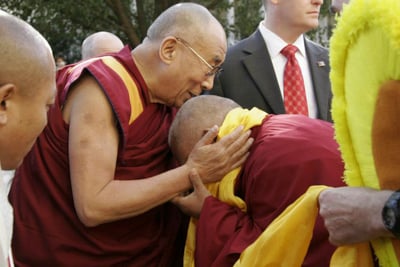
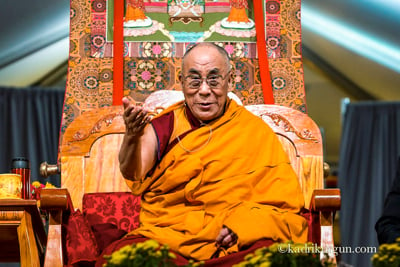
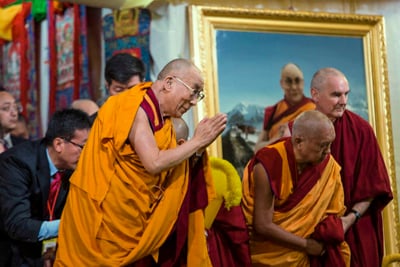
Wonderful video of the event and related videos, including Lama Zopa Rinpoche’s October 17 teaching at Kurukulla Center, can be found on Kurukulla Center's Youtube page, and there are many fantastic photos on the Kurukulla FaceBook page. In a couple of the above photos you will see Lisa Sawlit’s wonderful portrait of His Holiness that we mentioned in last month’s eletter.
We have also just posted two interviews with His Holiness on the LYWA website: a question-and-answer session about Buddhism with students at Tushita Retreat Center, Dharamsala, in May 1989; and an interview with His Holiness the Dalai Lama in Dharamsala, India, on November 2, 1988. (Interview transcripts kindly provided by Ven. Thubten Wongmo.)
Lama Zopa Rinpoche at LYWA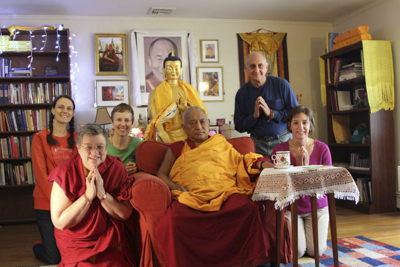 On the day after His Holiness' visit, Lama Zopa Rinpoche gave a teaching that was streamed live to students in Singapore and around the world.
On the day after His Holiness' visit, Lama Zopa Rinpoche gave a teaching that was streamed live to students in Singapore and around the world.
In this talk Rinpoche taught on remembering death, gave commentary on a brief lamrim teaching by Ngulchu Dharmabhadra, and spoke about the five powers.
You can view a video of the talk, or just listen to the audio, and read along with the transcript on our website here.
Pictured here with Rinpoche (left to right): Mer Stafford, Archive Assistant; Ven. Ani Tenzin Desal, Office Manager and Technical Archivist; Wendy Cook, Assistant Director; Rinpoche; Nick Ribush, Director; Jennifer Barlow, IT and Finance Manager.
What Else is New On Our Website
This month we posted an amazing compilation with detailed instructions on the refuge preliminary practice from various teachings by Lama Zopa Rinpoche in India and Nepal. Compiled and edited by Ven. Thubten Wongmo.
Listen online to teachings given by Rinpoche before a Chod initiation at Maitripa College in Portland, OR in June 2009. In this teaching Rinpoche talks about our precious human rebirth and the importance of practicing Dharma in our daily lives. Thanks to our friends at Maitripa, and our audio editor Jonathan Steyn, this recording is crystal clear and very easy to listen to.
We have also just posted excerpts from Rinpoche's teachings at the annual Kopan lamrim course in 1979:
-
Practicing Lamrim as a Householder: how to generate the realizations of the stages of the path;
-
The Great Yogi Milarepa: how it's possible to achieve enlightenment in one brief lifetime;
-
The Shortcomings of Anger: a method for controlling our anger; and
-
The Yoga of Sleeping: how we can transform sleep into virtue.
As always, you can read the entire course transcript or download it as a pdf here.
New Advices in Rinpoche's Online Advice Book
There were 14 new advices posted in Lama Zopa Rinpoche's Online Advice book, including:
-
Extensive practice advice for sangha about which Rinpoche comments: "Actually this is very, very, good advice for other monks and nuns who are studying at Sera, Kopan, Nalanda, Istituto Lama Tsongkhapa, etc. and for other students. This explains how to make the life Dharma. One thing is how to study, but it’s also how to make the life Dharma."
-
Advice on guru devotion on the power of faith, "the root from where enlightenment comes."
-
Advice on offering service to the guru, written to a student who dedicated her practices to Rinpoche’s good health, long life and happiness.
-
A long advice to a student looking to deepen her practice, a "new path in the Dharma."
You can see a list of all new advices added in October here.
Additions to Our Image Gallery
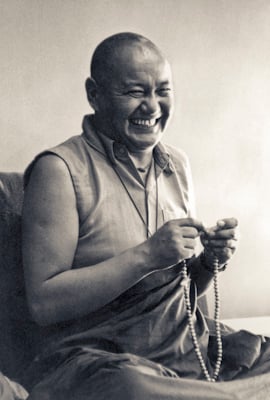 Our latest addition to our online Image Gallery are more images from the 1978 series of Lama Yeshe teaching at University of California Santa Cruz, donated by the photographer, Jon Landaw. This fabulous series truly captures the energy and personality of Lama as he is teaching. Thanks to David Zinn for preparing these images and managing our ever-growing image archive.
Our latest addition to our online Image Gallery are more images from the 1978 series of Lama Yeshe teaching at University of California Santa Cruz, donated by the photographer, Jon Landaw. This fabulous series truly captures the energy and personality of Lama as he is teaching. Thanks to David Zinn for preparing these images and managing our ever-growing image archive.
As many of you know, we are getting near the end of our four-year editing on Adele Hulse's official Lama Yeshe biography, Big Love. Over the years, many people have sent us precious photos like these and we are currently going through these making selections for the book. Be sure to follow our Big Love blog and read excerpts from this incredible story.
We know there are more pictures out there! If you have any photos of Lama Yeshe, Lama Zopa Rinpoche or FPMT centers and activities, please get in touch with me at [email protected]. We are especially looking for photos from the late 1960s to 1985. Thank you so much.
We leave you with an excerpt from Lama's biography which chronicles these events, and includes an excerpt from these teachings that Lama gave at UCSC.
Thank you once again for your kind interest in and support of the Lama Yeshe Wisdom Archive.
Much love, 
Nick Ribush
Director
This Month's Teaching: Lama Yeshe's Biography 1978: Becoming a College Professor
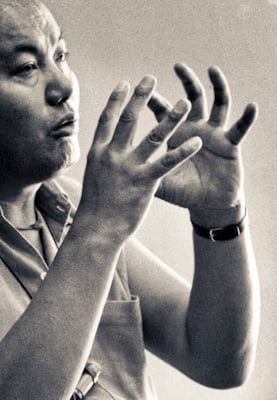 Lama Yeshe had expressed a desire for an American university “experewence” on many occasions. In the spring of 1978, Jan Willis was able to fulfill Lama’s wish. She arranged for him to teach a course on Tibetan Buddhism at the University of California’s Oakes College on the Santa Cruz campus during the spring quarter, which ran approximately from mid-March through the end of May. He was to teach Jan’s UC Santa Cruz class while she was on leave at Wesleyan University.
Lama Yeshe had expressed a desire for an American university “experewence” on many occasions. In the spring of 1978, Jan Willis was able to fulfill Lama’s wish. She arranged for him to teach a course on Tibetan Buddhism at the University of California’s Oakes College on the Santa Cruz campus during the spring quarter, which ran approximately from mid-March through the end of May. He was to teach Jan’s UC Santa Cruz class while she was on leave at Wesleyan University.
“We had to locate some Tibetan documents in order to prove that Lama really was highly educated,” said Jan. “Everything was very easy to arrange, probably because Lama was so keen to do it. He lived in student housing not far from Robbie and Randy Solick who lived nearby in the apartments designated for married students. Robbie was appointed to be Lama’s official teaching assistant with Jon Landaw acting informally as a second assistant. Robbie and Jon led discussions and helped students with Buddhist terminology. Lama was to lecture two mornings a week and be available for interviews in his office on Wednesday afternoons.”
Together with a work permit, Lama also received a Social Security card. Lama Yeshe loved everything about the job, especially spending his American salary, much of which was spent on flowers. He was particularly fond of roses and got to know all the florists in Santa Cruz.
Lama’s “first family,” the Solicks, who now had three small daughters, provided a haven for him. He loved to sit back and watch the evening news on TV with Robbie; he even showed some interest in sports, probably for Robbie’s sake. He also enjoyed long talks with the UCSC Chancellor who, like him, had a heart condition.
Being responsible for the shopping at Kopan had given Ngawang Chötak enough expertise to land a job in California as a purchasing officer. Unfortunately, his employer was going broke, so as a result Chötak was free to move into Lama’s apartment, sleeping upstairs in a little room off the kitchen.
“We did a lot of cooking together,” Chötak recalled. “Lama was teaching me how. For breakfast he liked French toast covered in butter and syrup, as well as sausage or bacon and strong coffee with whipped cream. If Anila Ann had seen that she would have gone nuts. She was always on at me about his diet. I agreed with her at the time but Lama claimed nobody knew his body like he did. ‘I need strong food to keep it going—steak and milk.’ He made these big momos, but he wouldn’t let me buy ground beef for them. It had to be the best steak, which he’d then chop up himself. He didn’t like ground beef. ‘You don’t know what’s in that!’ Lama loved his coffee. He started adding ‘half and half’ [a dairy product that is a mixture of milk and cream] but then he said it wasn’t strong enough, so he moved on to whipping cream.
“One of his little games was to lie on his bed and play dead when I came into the room. It scared the hell out of me but he thought it was a great joke. He wouldn’t study too much for his lectures; he knew exactly what to tell them. He spent a lot of time looking at magazines and had me read him some long articles. He also watched Roots on TV.
“Many, many people came to see him. Judy Weitzner always had access. He was indefatigable and worked me to death. He’d want tea for twelve people at 2:00 am or it would be something else. But he was just bliss to be with.”
Chötak continued. “One day I took him along to a Hopi Indian reservation and told him their prophecy about us all coming to the end of what they call the ‘fourth world.’ According to the Hopi, people will not be able to travel around so much anymore and many other aspects of life as we know it will disappear. ‘I think they’re right. Why do you think I travel around the world introducing Mahayana in so many different places at once?’ said Lama.”
Karuna Cayton’s younger sister, Lori, enrolled in Lama’s class and moved into the student building directly opposite his apartment. “My thing was always just to sit and watch him,” she said. “The course was held in a small auditorium. Jon Landaw pushed a table up against the blackboard and placed a Tibetan carpet and a cushion on it. Lama came in, climbed right up onto the table and sat down.”
He was a hit from the very first session and his lectures were packed. The Vajrapani people gate-crashed every one, driving in from their primitive huts and showering in the university gym. They were careful not to act devotionally, which would have been inappropriate in a college atmosphere. There were no prostrations or the traditional offering of khatas, flowers or incense, but whenever Lama entered the auditorium, always from the back of the room, the whole audience automatically stood as one. No one in America stands for professors. On the first day the students didn’t even know he was in robes until he got down to the front of the room. Nevertheless, they all stood up, every day.
Lama was not looking for converts; his message was much more subtle.
From Lama Yeshe’s lectures at UC Santa Cruz, spring 1978:
Although anyone who strives to reach buddhahood does so expressly to benefit others--primarily through giving teachings--Shakyamuni did not begin teaching immediately after his attainment of enlightenment. By holding back at first, he showed that the profound realizations of enlightenment are not something the ordinary, superficial human mind can be expected to grasp easily. His discovery was beyond normal conceptions and words, beyond expression or description. He knew how difficult it would be for others to understand what he had realized, and so he remained silent. But after seven weeks of enjoying the bliss of enlightenment in the forest by himself, he was requested to teach for the benefit of all, and agreed to do so.
Buddha’s hesitation to teach until sincerely requested emphasizes an important characteristic of his teachings in general. They are never forced upon others against their will. “Here are fantastic teachings! Why don’t you come and join us?” Neither are disciples sent out into the streets to convince people how miserable they are, offering salvation to those who will come and join them. Buddha’s teachings were never presented in this way, and the Tibetan traditions still follow the custom of waiting until someone asks before giving them teachings.
Why are Buddhists specifically instructed not to thrust their beliefs at other people or to declare, “I have discovered the best way of life and if you don’t follow it as well, you are lost”? According to Buddha’s teachings this approach is both unskillful and unrealistic. When someone has a profound experience, be it disastrous or fantastically blissful, it is a completely unique and personal event. It is foolish to think that an account of such a private experience will be as meaningful to another as the experience was to oneself. Even if we tell our best friend what we have discovered it is still impossible to convey the true essence of our experience to him. Since what we are saying is necessarily expressed through words and concepts, even a sympathetic friend will probably not grasp exactly what we want him to feel. True communication on spiritual matters is very difficult.
What this shows is that we are all living quite different lives from one another. Though we may share similar patterns of perception and behavior, our internal experiences are unique and highly individual. We each live in the private universe of our own mind. Consequently, any attempt to force our spiritual convictions on others or share with them our devotional experiences which, if genuine, are always of such an intensely personal nature, is misguided and can easily end in frustration and misunderstanding.
Ordinarily, if we feel that someone is a good speaker we might praise him by saying, “What a powerful lecture he gave!” But from a Buddhist point of view the true power of speech is not to be found in speech itself. Behind the words, within the mind of the speaker, must be a living experience of luminous penetrating wisdom. This wisdom gives a buddha’s speech its power. Such power has nothing to do with an ordinary person’s eloquence. It is solely a matter of inner realizations. Since a buddha is one whose realizations are complete, his speech has the power to affect each listener in a profound and deeply personal way. Not only that, but an enlightened being can arouse understanding without having to use any words at all.*
Lama’s course was a survey of the origin, evolution and spread of Buddhism, placing special emphasis on the lives of Shakyamuni Buddha and later Indian masters. Given that Lama himself was an active participant in the present-day movement of Buddhism from Asia into Western cultures, not surprisingly his course also examined the various ways that the Buddhist teachings had moved from India into the very foreign culture of Tibet. This included an exploration of the history and development of the various schools of Buddhist thought and the differences between them. At the end of each session Lama would answer questions. To one student who claimed that working for others to gain merit was self-interest, Lama replied, “I can only work for my own enlightenment.” To those who raised objections or who expressed opposing views he said, “Good! I like debate.”
“He answered every individual question all 150 of us could come up with,” said Debra Lockwood. “Lama Yeshe treated us all as equals and gave each of us a voice. He also instilled in me the possibility of attaining enlightenment in a single lifetime because the complete teachings for doing that were all at hand. He could also be outrageous. He related directly with the students, but strictly within the boundaries of his Vinaya vows. No wine, women and song.” Debra Lockwood and Greg Hillis were among the few students at that course to go to Kopan.
During office hours Lama Yeshe patiently listened to everyone’s tales of woe—horrible divorces and family traumas. He saw anybody at any time and Robbie Solick often had to step in to ensure he got some time for himself. “He was so powerful,” said one new student. “I loved to watch him being so patient with people with whom I had absolutely no patience at all.”
One afternoon, a Vajrapani resident jumped the interview queue. “I was suffering from the most painful stress and told Lama I was freaking out! ‘Oh, don’t worry,’ said Lama, ‘you think Guru Shakyamuni doesn’t have an answer to your problem? You do tummo [inner heat] meditation, take some nice walks and relax.’ When I got up to leave he grabbed me, said some mantras and blew on my heart. After a few minutes of this he said, ‘Okay, goodbye, dear.’ I know he released something in my heart that day. I could feel it,” said the young man.
“One day in a lecture Lama did a little snap of the fingers and twist of the wrist and pointed in my direction, causing the greatest delight I have ever experienced,” said another student. “It was like the floor dropped out from under me and what was left was this exhilarating joy. Lama Yeshe was known as a populist but he was really a master of the yogic requirement of ‘super-hiding,’ of never revealing one’s practice or realizations. He was so much more than a sweetie-pie. Outwardly he taught us lamrim, but secretly he taught the highest tantric practice to those who could fix their thoughts on him. Superficially he was a nice Buddhist monk, but inwardly he was a miracle-making mahasiddha [a highly realized meditator] of the first order.”
The student continued his account. “Some time later I found Lama Yeshe could enter my dream states. I was sleeping and Lama was far away. I heard a telephone ring and then Lama was in my dream. I was convinced he was performing initiations. When I asked Lama Zopa about it he got excited, but pretended he didn’t quite understand what I was saying. Geshe Rabten was even cooler about it, indicating that such things happen all the time. But all I had to do was think about Lama Yeshe and there was an automatic response in me.”
“Lama was forever telling his students what to do,” Robbie Solick explained. “He’d say, ‘You be a monk,’ ‘You go into retreat,’ ‘You do this or that.’ One day I asked him why he never told me what I ought to do. He said, ‘Your family is your responsibility and Dharma practice right now. It is not necessary for me to tell you what to do.’ Randy and I both got that message so we made no demands on his time.
*Note: Teaching excerpt from archive #116. Excerpted from the version edited by Jon Landaw (Turning the Wheel) that was published in Wisdom Energy 2 in 1979. You can read the entire article here.
Excerpted from the forthcoming biography of Lama Yeshe Big Love, by Adele Hulse, edited by Ven. Connie Miller, due in late 2013. To read more excerpts from the biography visit our Big Love Blog.































